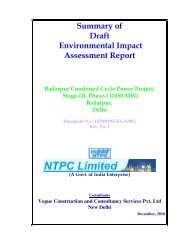proposed integrated complex for delhi judicial academy
proposed integrated complex for delhi judicial academy
proposed integrated complex for delhi judicial academy
You also want an ePaper? Increase the reach of your titles
YUMPU automatically turns print PDFs into web optimized ePapers that Google loves.
Rapid Environmental Impact Assessment (REIA) Study <strong>for</strong> Proposed Integrated Complex <strong>for</strong> Delhi Judicial Academy,<br />
National Law School, and National Institute <strong>for</strong> Mediation & Conciliation at Dwarka, New Delhi<br />
4.8.1 Seismic Stability<br />
The project area falls in Zone-IV of Seismic Zoning<br />
Map of India (Figure 4.10). Delhi region shows<br />
active and prolonged seismic history. Earthquakes<br />
of 3 to 6.7 magnitude on Richter scale have<br />
occurred in past around Delhi. The most active area<br />
of the region is considered to be the trijunction of<br />
the Delhi-Hardwar ridge, Lahore-Delhi ridge and<br />
axis of Delhi folding. Most of the shocks are<br />
interpreted to have shallow focus and have locations<br />
to the West of Delhi. Maximum concentrations of<br />
the earthquakes epicentre have been around<br />
Sonepat, Rohtak and Gurgaon region and the<br />
tectonic elements of the area are considered capable<br />
of generating an earthquake of magnitude 7 on Richter scale. The seismic factors have been<br />
appropriately incorporated in the civil designs <strong>for</strong> the <strong>proposed</strong> <strong>integrated</strong> <strong>complex</strong>.<br />
4.8.2 Geology<br />
The geological <strong>for</strong>mations of the NCT Delhi date from the proterozoic to the Quarternary ages. The<br />
generalized succession of the rock <strong>for</strong>mations reported are the Quaternary era represented by recent<br />
soils, alluvium, blow sand and nodular limestone; Pegamites and the basic intrusives belonging to<br />
post Delhi intrusives; and the Alwar quartzites of the Delhi system. The area is a part of the Indo-<br />
Gangetic plain. Figure 4.11 shows the geological map of NCT - Delhi.<br />
The greatest part of Delhi lies in the alluvium, but the small hills and ridges in and around New<br />
Delhi consist of Alwar quartzites. Delhi area is occupied by quartzites interbedded with mica schist<br />
belonging to the Delhi Super Group, uncon<strong>for</strong>mably overlain by unconsolidated Quaternary to<br />
recent sediments. The quartzites are grey to brownish grey, massive to thinly bedded and<br />
structurally <strong>for</strong>m a coaxially refolded regional anti<strong>for</strong>m plunging towards southwest. The major<br />
planar structure strikes NE-SW with steep southeasterly dips. These quartzites occur in the central<br />
and southern part of the area while the Quaternary sediments comprising older and newer alluvium<br />
cover the rest of the area. The older alluvium comprises silt, clay with minor lenticular fine sand<br />
and kankar beds. The newer alluvium mainly consists of unoxidised sands, silt and clay occurring<br />
in the older and active flood plains of Yamuna river. The thickness of the alluvium, both on the<br />
eastern and western side of the ridge, is variable, but it is generally larger to the West of the ridge.<br />
The project area is located in the western part of the NCT Delhi, on older alluvial plains. They are<br />
mostly covered with quaternary sediments belonging to mainly older alluvium soil. These older<br />
79
















